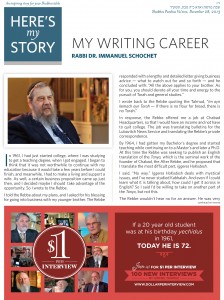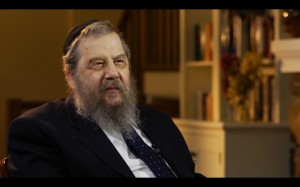HMS: My writing career
In 1961, I had just started college, where I was studying to get a teaching degree, when I got engaged. I began to think that it was not worthwhile to continue with my education because it would take a few years before I could finish, and meanwhile, I had to make a living and support a wife. As well, a certain business proposition came up just then, and I decided maybe I should take advantage of the opportunity. So I wrote to the Rebbe.
I told the Rebbe about my plans, and I asked for his blessing for going into business with my younger brother. The Rebbe responded with a lengthy and detailed letter giving business advice – what to watch out for and so forth – and he concluded with: “All the above applies to your brother. As for you, you should devote all your time and energy to the pursuit of Torah and general studies.”
I wrote back to the Rebbe quoting the Talmud, “Im ayn kemach ayn Torah – If there is no flour for bread, there is no Torah.”
In response, the Rebbe offered me a job at Chabad Headquarters, so that I would have an income and not have to quit college. The job was translating bulletins for the Lubavitch News Service and translating the Rebbe’s private correspondence.By 1964, I had gotten my Bachelor’s degree and started teaching while continuing on to a Master’s and later a Ph.D. At this time the Rebbe was seeking to publish an English translation of the Tanya, which is the seminal work of the founder of Chabad, the Alter Rebbe, and he proposed that I translate the most difficult part, Iggeres HaKodesh.
I said, “No way.” Iggeres HaKodesh deals with mystical issues, and I’ve never studied Kabbalah. And even if I could learn what it is talking about, how could I get it across in English? So I said I’d be willing to take on another part of the Tanya, but not this.
The Rebbe wouldn’t hear no for an answer. He was very insistent that I do it. I argued with him for about ten or twenty minutes, until he wore me down and I finally said, “Okay, I’ll try.”
And don’t you know – when I started, I got into it. It was hard but I really became absorbed in it, and in order to do the Alter Rebbe justice, I started studying Chasidism seriously for the first time in my life. In all my years in the yeshiva, I had barely scratched the surface of what there is to know in chasidic philosophy.
It took me two years – until 1966 – to get it done. And in the process I had to read and understand Eitz Chaim and other teachings of the Ari, the great medieval Kabbalist whose explanations are the basis of all the mystical concepts of Chasidism. I had never learned this material before and suddenly I had to jump in and start swimming in it, and somehow find what I needed to properly translate the Iggeres HaKodesh.
And because of that I decided to write a general introduction to the mystical writings of the Alter Rebbe to make the Iggeres HaKodesh easier for people to grasp.
So I did that, and I sent it to the Rebbe, who suggested that it should be a separate book. Besides using this material to write a general introduction to the Iggeres HaKodesh, he said I should also publish a separate, more comprehensive, book on the subject. I followed his advice and that book came to be called Mystical Concepts in Chasidism.
And after that the Rebbe wanted me to write more. He kept on urging me to keep writing – sometimes in sharp terms, sometimes in gentle terms, sometimes in humorous terms, but always pushing me to write more. Every time I saw him, he would ask me, “What’s with the next book? I’ve been waiting for so long already for another book…” And because of his constant prodding, I eventually came to write some 35 books.
One book that was really important to the Rebbe was an index –maftechos – to the works of the Maggid of Mezeritch, who had been the Alter Rebbe’s teacher. To me, this was a horrible job. The Maggid’s works are extensive, and they are not easy to read or understand. So I didn’t want to do it. But the Rebbe would not let go. Every contact I had with him, there was always the question: “What’s with the maftechos?”
I told him, “This project is too complex and it really requires total immersion and concentration, and I just can’t do it.” I even offered to pay somebody else to write it. I said, “Let somebody do it who is used to doing things like this and knows how to go about it, because I don’t.”
In 1977, shortly before the Rebbe had suffered his heart attack, I had written him a letter. Of course, once his medical condition became dire, I expected no reply. Yet I got a reply a week after his heart attack – a piece of paper with just one word: “hamaftechos?” meaning – “the indices?”
The Rebbe just had a heart attack, he was bedridden, and this is what he was concerned about?! That shook me up.
So I sat down to work, and where before I just couldn’t get into it, now, it all came together. I got it done in two months’ time. The initial index was about 30 pages, and later I expanded it to 200 pages, because I got into learning all of the Maggid’s teachings.
But I had to be pushed to do it, and the Rebbe knew when and how to push the right buttons. Here he was after a heart attack, and during that first week no letters went out from him – maybe only two or three – and one of them was “hamaftechos?”
The late Rabbi Dr. J. Immanuel Schochet, of blessed memory, was an authority on Jewish philosophy, mysticism and Chasidism. He authored and translated some 35 books, including biographies of the Baal Shem Tov and the Maggid of Mezeritch. He was interviewed in Wilmington, Delaware in June, 2011.
This week’s Here’s My Story is dedicated
in honor of our Dear Rebbe
By Miriam and Moshe Fishman, Los Angeles, CA
& Anonymous








No Comments to “HMS: My writing career”